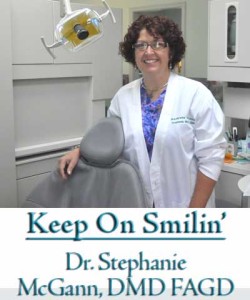New research shows dental pulp could be prime source for tissue building blocks
By Dr. Stephanie McGann, DMD, FAGD, Columnist, The Times
 Stem cells have made news over the last 15 years. They have been the focus of much scientific excitement and much political controversy — and now it’s possible teeth could be a key source for these building block cells.
Stem cells have made news over the last 15 years. They have been the focus of much scientific excitement and much political controversy — and now it’s possible teeth could be a key source for these building block cells.
What is a stem cell? Simply put a stem cell is an undifferentiated cell that has the potential to develop into many different cell types in the human body. Through the process of cell division, these cells can become heart muscle, blood vessels, nerve tissue or other organs. The ultimate goal of stem cell therapy would to be able to replace a damaged part of a patient’s body with new tissues grown from the patient himself. Scientists are researching how to use stem cells. This area of research is moving quickly and some stem therapies are already being used.
Early in stem cell study the only stem cells scientists could use were embryonic stem cells. This led to the political controversy and a slowdown in research. Fortunately scientists are stubborn and they found some stem cells in adults. The tissues that can be regenerated from adult stem cells can vary depending on the source of the adult cells. Embryonic cells are now collected from the umbilical cord and placenta that are discarded at birth. Families may elect to “bank” this cord blood and preserve the stem cells.
Stem cell research is going to lead to treatment and therapies that will make it possible to one day treat or cure a person with their own tissue. We now know that there are different types of stem cells and depending on where they are found will determine what they have the potential to become.
We often hear of patients needing an organ or tissue transplant to survive and how difficult it is to find a matching donor. In the world of stem cells, today if the patient was fortunate enough to have his or her stem cells banked, many treatments could be completed using the patient’s own stem cells to provide tissues that are a perfect match. No waiting and hoping for matching donors and less need for anti-rejection medications. Banking stem cells is certainly a great option.
Why does a dentist care about this? Stem cells have recently been found in dental pulp tissue — the center of the tooth. These cells can be saved from some baby teeth and healthy permanent teeth. The dental stem cells can be used to regenerate tooth structure, bone, muscle, nerve cells and connective tissues. Studies have shown that dental stem cells have already been used to regrow jaw bone and connective tissues. Dental stem cell researchers are optimistic that stem cells from teeth could play a role in treating Parkinson’s disease, diabetes, spinal cord injuries, heart attacks and possibly even Alzheimer’s disease.
A service is now available to bank these stem cells. Once the tooth is removed by a trained dentist, it is sent to a stem cell lab to verify the viability of the stem cells and then it is cryopreserved — or frozen at extreme temperatures — to maintain the cell viability. Not every tooth is a candidate for collecting stem cells. Teeth that have had root canal therapy or certain dental fillings are no longer able have their stem cells collected. Dental stem cell research is still in the early stages but the early results are promising.
While nobody can predict the future it may make sense to consider saving stem cells for the future. If you didn’t bank cord blood when your kids were born, it’s not too late.
Dr. Stephanie McGann is a resident of the Unionville area and along with her partner, Dr. Marie Scott, operates The Brandywine Smile Center, a family-friendly dental practice in Concordville. She is a Fellow of the Academy of General Dentistry.






